Kate Zabriskie, a business author, once said that the customer’s perception is your reality.
Well—
If you want to learn what your business looks like through your customers’ eyes, there’s a way to do so.
It’s called a customer satisfaction survey.
And you’re about to learn how to make one in no time!
What is a customer satisfaction survey? And why it’s vital for your business
Let’s start with the basics.
A customer satisfaction survey is a questionnaire that measures the customers’ level of satisfaction with a product or service. Satisfaction surveys capture the changes in customers’ perceptions over time and help businesses see what their customers need and what issues they struggle with.
In our modest opinion, every business should be interested in their customers’ challenges and the level of customer satisfaction.
And if you have doubts—
Know that 80% of consumers say they would switch to a competitor only after one bad interaction. As a business owner, you will want to know about the first bad experience and prevent the next one from happening.
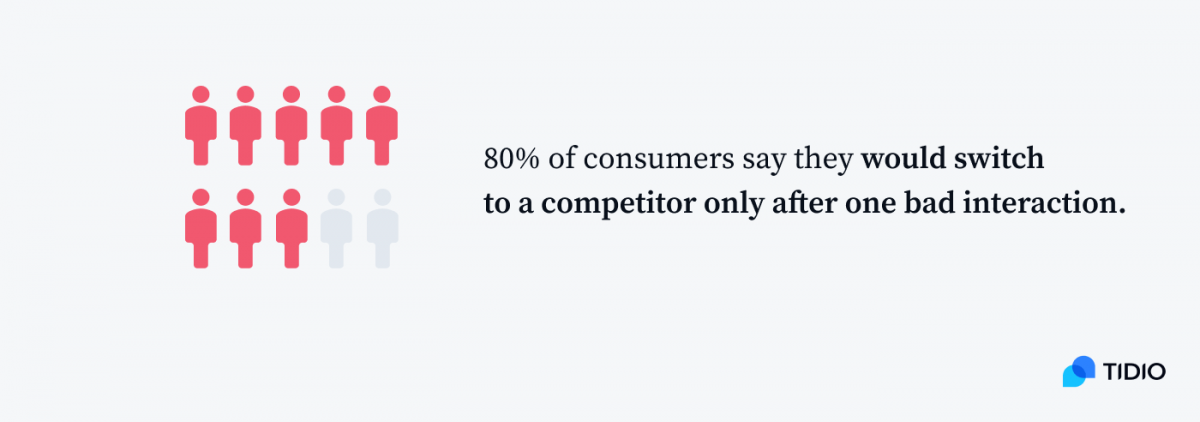
At the same time, a whopping 94% of American customers will recommend a company whose service they rate as “very good.” And only delighted customers can become your promoters and attract new customers (and reduce your marketing expenses at the same time).
How do you know whether you have chances for that?
You survey your customers!
Three customer satisfaction survey types
Now—
Let’s have a closer look at the types of customer satisfaction surveys.
1. NPS survey®
Net Promoter Score (NPS) shows the level of customer satisfaction and brand loyalty, providing you with a somewhat private customer experience research.
NPS surveys consist of a single question that asks the customers how likely they are to recommend your product, service, or company to others. Respondents use a scale from 1 to 10.
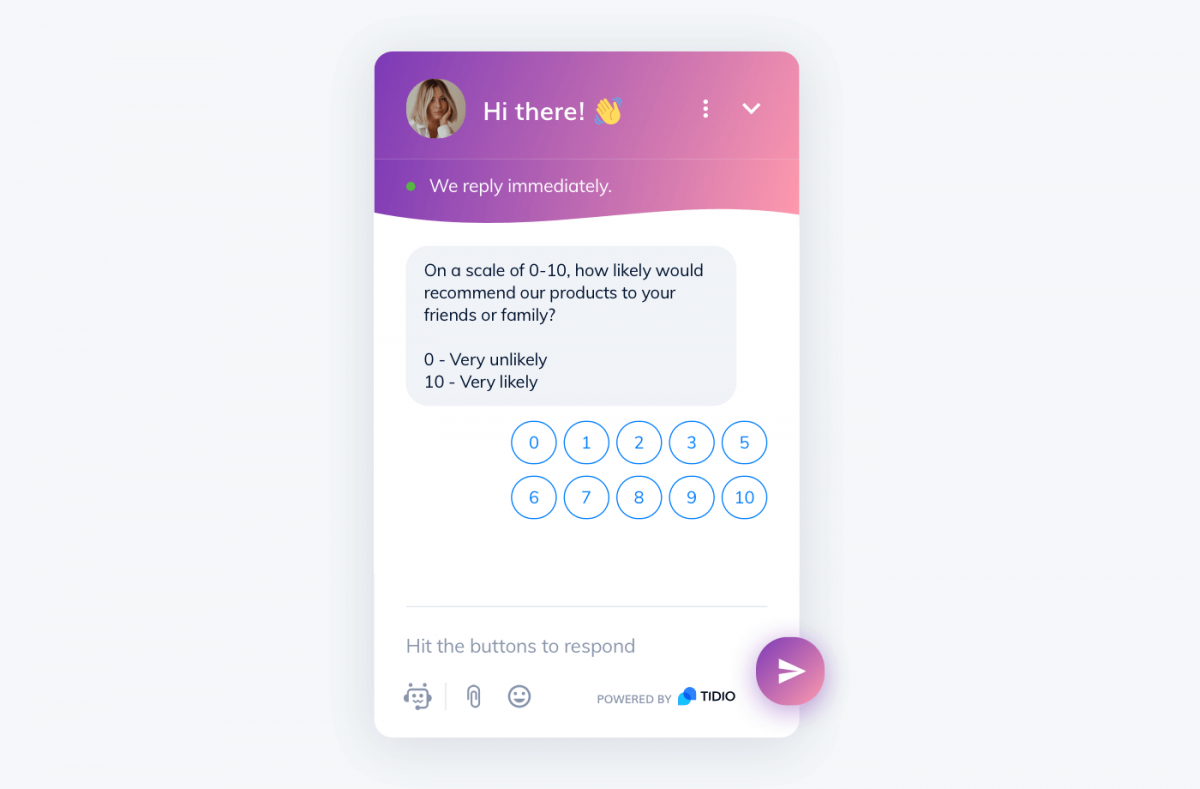
These satisfaction post chat survey responses generate a score ranging from -100 (minus hundred) to 100 (a hundred).
Based on the score, you can group your customers into three categories:
- Promoters: Those are the customers who gave you a rating of 9 or 10. They are happy and loyal. As the name suggests, promoters might promote your company among the people within their social or professional circles.
- Passives: Those are the customers who gave you a rating of 7 or 8. Their experience with your company is average. They are satisfied with your services but might switch to your competitors if an opportunity arises. Passives are the neutral group among your customers. They won’t spread negative comments but won’t promote your brand either.
- Detractors: Those are the customers who gave you a rating of 6 or lower. They are not happy with your products or services. Detractors share their bad experiences with others and hurt the company’s reputation. They won’t buy from you again and will discourage others from buying from you, too.
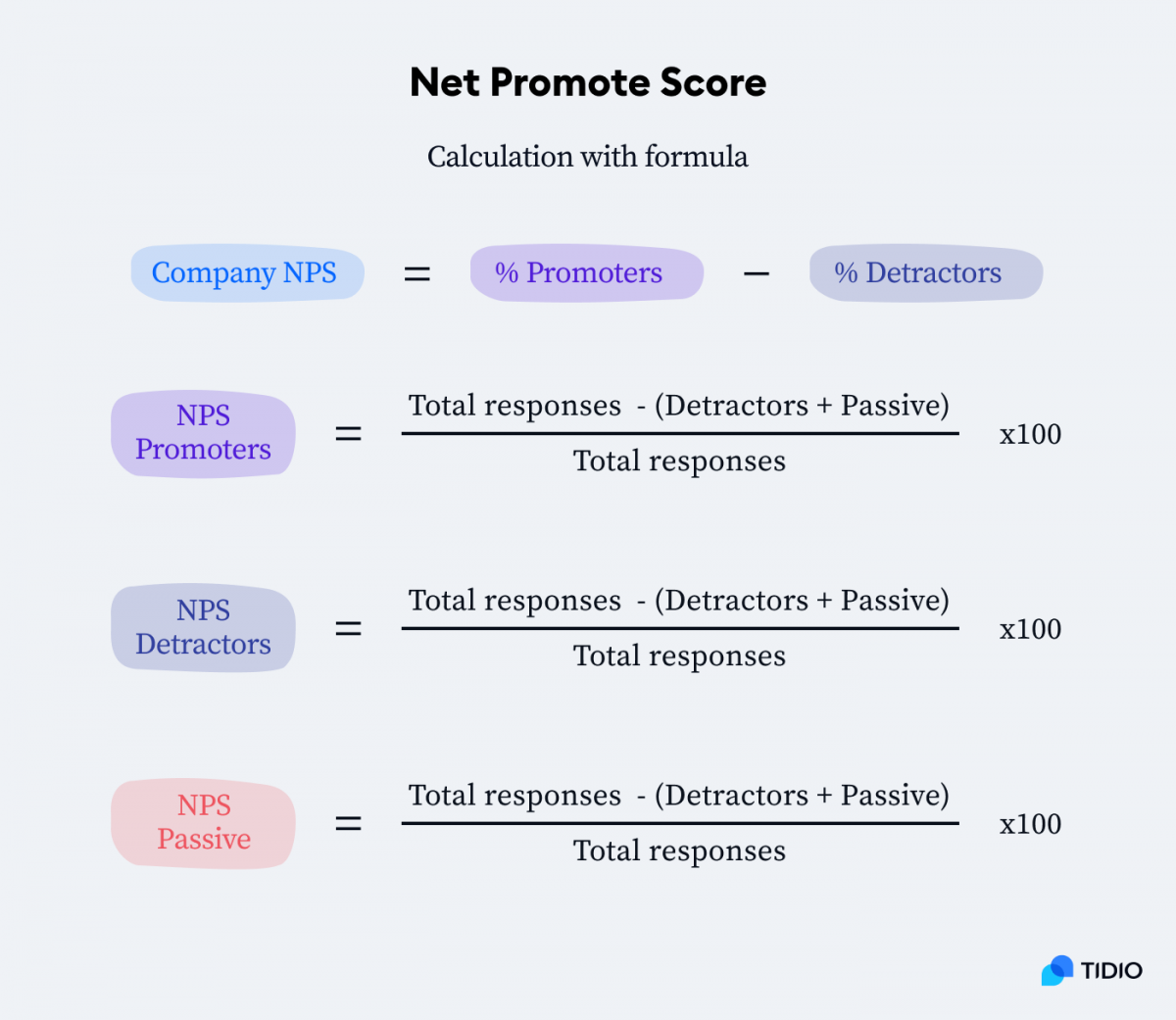
2. CSAT survey
Customer Satisfaction (CSAT) measures the degree to which customers are satisfied with a service, product, or experience.
CSAT surveys usually contain one simple question to which visitors can respond with a set of responses (e.g., “Yes/No,” “Very/Neutral/Not at all,” or a numerical scale “0-5”).
They may contain open-ended questions where the customer provides more information or justifies their response.
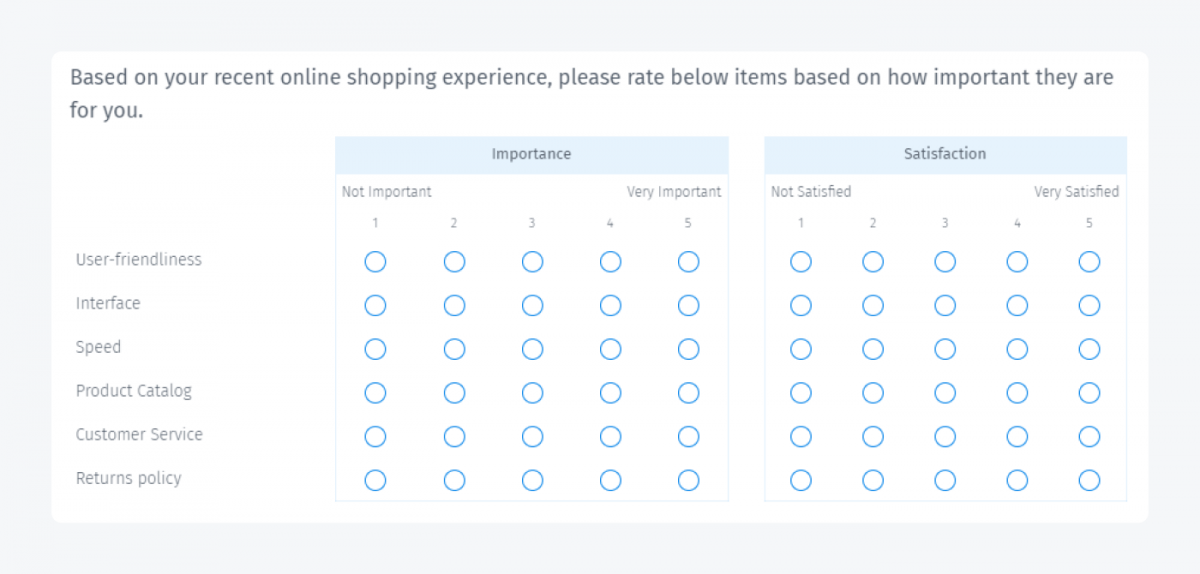
CSAT is calculated by dividing all the positive responses by the total number of responses and multiplying by 100.
For example, if you have 24 positive responses and a total of 60 responses, your CSAT would be 24 / 60 x 100 = 40%.
3. Customer effort score (CES)
The Customer Effort Score is a single-question survey that measures how much effort it takes for customers to use your product features or resolve a problem through customer support.
CES surveys usually ask the respondents to rate their experience on a numerical or a visual scale that can include emoticons ranging from angry to happy faces.
A typical CES scale includes 1–5 (Very low effort–Very high effort), 1–7 (Extremely easy–Extremely difficult”), or Easy-Neutral-Difficult.
The answers are averaged to explain how much effort customers need to put into a particular process.

Five steps to making a meaningful customer satisfaction survey
A well-designed customer satisfaction survey will give you insights to benchmark your customers’ happiness.
Just remember that for each business, creating a customer satisfaction survey process will be different.
Step 1: Set the goals
Start with the basics:
- Who to survey: New customers? Long-term customers? Users of a specific feature or those who subscribe to a certain plan? The more specific your audience is, the better.
- What to measure: CES, CSAT, or NPS? Decide which metrics will be the most valuable for you.
Step 2: Choose the best medium
Luckily, you don’t need a fancy customer satisfaction survey software to collect feedback. There are six main communication channels you can choose from:
- Email: About 85% of people use their devices to check their mail, which means that they can comfortably respond to your client satisfaction survey any time, anywhere, and without accessing your website, which makes it one of the most popular survey mediums.
- Website Intercept Survey: It’s an online survey that asks visitors for feedback to help you understand their intent, evaluate their online experience, and research your website’s usability (or store). You can use a pop-up on your website or an on-page survey that appears in the corner of the screen.
- SMS surveys: Their advantage is that it’s a fast communication channel that is familiar to your audience, but the drawback is that you need to have phone numbers from your audience.
- Social Media: You can measure your customers’ satisfaction with reviews, live polls, and surveys via social media channels such as Facebook, Instagram, LinkedIn, or Twitter.
- Live chat: Almost 41% of shoppers expect companies to have a live chat. Interactions via a live chat can range from resolving queries to collecting customer feedback.
- Chatbots: They are non-intrusive, and you can customize their appearance to match your website. You can also decide which visitors will be engaged by the bot, as well as
Learn how to leverage AI-assisted support to boost client satisfaction
Step 3: Choose the right time
An airline company will have different survey timing than a SaaS business. At Tidio, we send a CSAT survey right after the conversation ends to have the feedback ASAP, but that might not be your objective at all.
The type of surveys also plays an important role. It’s pointless to send an NPS survey when a new customer has just joined your company.
Usually, companies send surveys at crucial moments of the customer lifecycle, such as:
- Midway through or at the end of the onboarding process
- Every half a year
- When customers churn
- After each interaction with the customer support team
- After a solution to a problem was offered
- During the renewal of a subscription
Suggested reading
Find out when is the best time to send emails.
Step 4: Choose the best questions
Now, it’s time to design good questions to measure your customers’ satisfaction levels—here are some of the best practices:
- Start with easy questions. Start with easy “Yes/No” questions, then move on to slightly longer questions like multiple-choice, and gradually introduce the open-ended questions.
- Be specific. Instead of asking “How was the registration process?” focus on its particular aspects—” Did you come across any issues while adding a credit card to your profile?”
- Allow skipping. Sometimes, people simply don’t know the answer. And if you don’t allow them to skip such a question, they will abandon the survey or provide dishonest responses that will skew your metrics.
- Keep it simple. Avoid long questions with complex sentence structures. Your respondents who are not English native speakers may misunderstand the meaning and, thus, give you the wrong answers. The same goes for using industry jargon or abbreviations that an outsider might not understand.
- Include various question types. Include Yes/No, multiple-choice, and open-ended questions to gather valuable data.
Customer satisfaction surveys generally have low response rates. To increase the chances for more answers, offer an incentive. For example: “Complete this survey and receive a small gift” or “Everyone who completes the survey will receive a 10% discount on our [product name].”
Step 5: Structure the survey in a respondent-friendly way
The survey structure will also determine whether your respondents will complete the survey or drop out somewhere halfway through.
Here’s how to structure your customer satisfaction survey form:
- Use a consistent rating scale. When you start your survey with a scale where, let’s say 1 = Very Satisfied, and 5 = Very Dissatisfied, your respondents will quickly adapt to it. If you suddenly switch to 5 = Excellent and 1 = Very Poor, they’re likely to get confused and give you the opposite answers.
- Show progress. If completing your survey takes a while, let your respondents see their progress. You can use a progress bar, percentage bars, or a question counter (e.g., 5/16) that will be visible on each survey page. If your survey consists of several individual sections, break them down into smaller ones.
- Optimize for mobile. People use mobile phones to do a lot of stuff, including watching videos, reading emails, and responding to customer satisfaction surveys. That’s why you must optimize your survey for mobile devices. If it is too difficult to work with on a small screen, your survey participation indicators will drop.
Read more: Discover how ADT Security Service used Tidio to boost customer satisfaction.
Questions types for customer satisfaction survey
Let’s now look at the types of questions you can ask and what purpose they serve.
1. Open-Ended Survey Questions
Open-ended questions allow your respondents to give answers in their own words. Also, unlike some other questions, they do not limit choices to a set of predetermined options.

When to use open-ended survey questions?
Open-ended questions uncover pain points and give you insights about a new customer segment you have recently started to target.
Disadvantages? Satisfied customers may want to share their feedback about your product/service, but few respondents feel like typing elaborated answers. Also, open-ended questions are notoriously hard to analyze.
Use text analysis tools to see patterns emerging from open-ended questions.
| Examples: “What other products would you like to see us offer?” “If you could change just one thing about our product, what would it be?” “What features would make our online services more convenient for you?” |
2. Rating scale survey questions
Rating scale questions, or ordinal questions (because the answers come in a specific order), are followed by a range of multiple-choice answers expressed on a numeric scale.
The scale can be a numeric slider, matrix table with radio buttons or checkboxes, emojis, or drop-down menus.
When to use rating scale survey questions?
This type of survey question works well whenever you want to assign a numerical value to your survey and/or visualize and compare trends for market research. Such questions are common in NPS and CSAT surveys.
| Examples: “How likely are you to recommend [product or service] to your friend or family? (0–10)” “How satisfied are you with the help you received from our Customer Service agent?” (1–5) “Based on your most recent live chat support, how easy or difficult was it to interact with the [company] agent? (1–6)” |
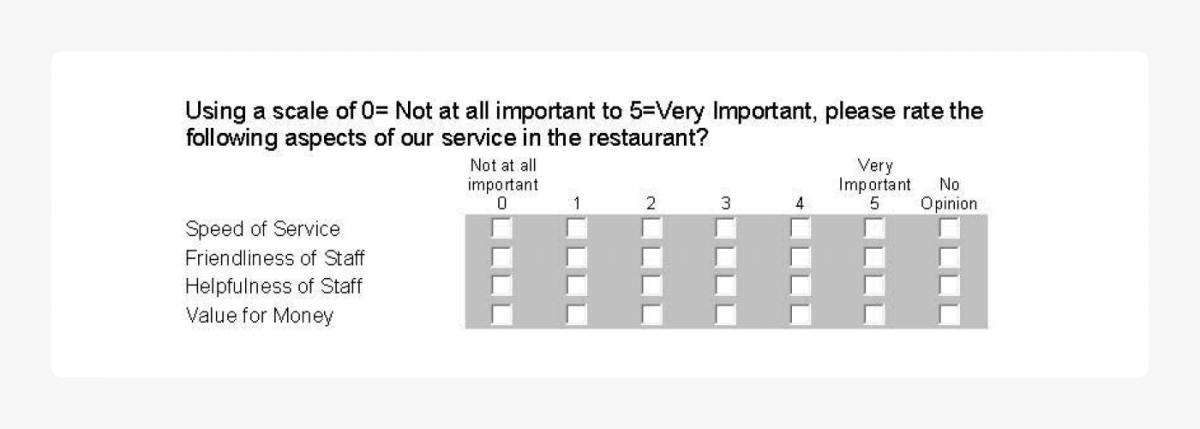
3. Likert scale questions
The Likert questions often use a 5- or 7-point scale. The scale captures a respondent’s level of agreement with certain statements or the intensity of their reaction toward something.
The scale develops symmetrically:
- The median number (e.g., a “3” on a 5-point scale) indicates neutrality
- The lowest number (always a “1”) indicates an extreme view (negative or positive)
- The highest number (e.g., a “5” on a 5-point scale) indicates the opposite extreme view (negative or positive).
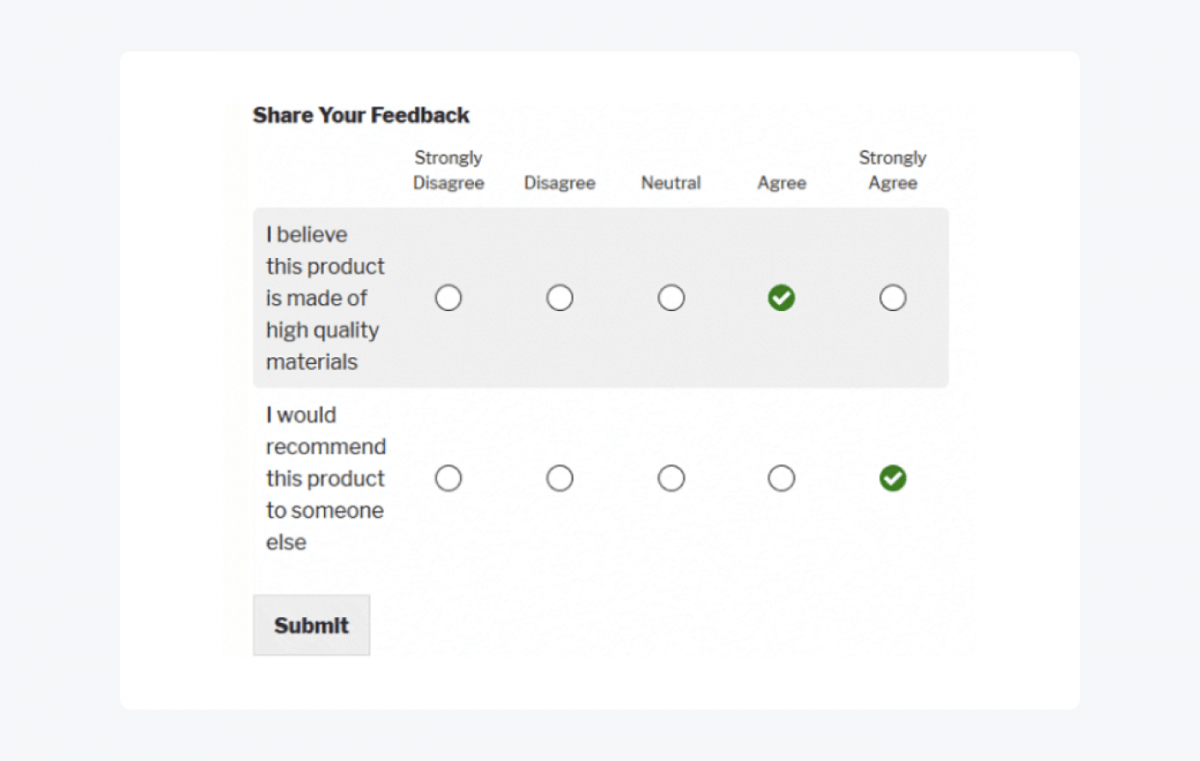
When to use Likert survey questions?
Likert-type questions are helpful when you already know a little what your customers think about your product or service. For example, suppose an open-ended question uncovered a complaint about the online payment process. In that case, you could use a Likert scale question to see how other customers feel about specific parts of that process.
| Example: “How strongly do you agree with the following statement: [your store] checkout process is easy to follow.” 1 – Strongly disagree 2 – Somewhat disagree 3 – Neither agree nor disagree 4 – Somewhat agree 5 – Strongly agree |
Suggested source
If you need more examples, check out this PDF with a variety of Likert scale examples.
4. Binary scale questions
Binary scale questions offer only two answer choices, such as “Yes/No”, “Thumbs up/Thumbs down,” “Sad face/Happy face,” and similar.
When to use binary survey questions?
These questions are an excellent way to segment your respondents and gather feedback about the user experience quickly. You can place a survey on a particular landing page (like the pricing page) and set up follow-up questions triggered by a specific answer.
| Examples: – “Did our service representative meet your needs?” (Yes/No) – “Are you satisfied with the answers about [issue] provided by our virtual assistant?” (Yes/No) – “Were you able to find on our website what you were looking for?” (Yes/No) |

100+ sample customer satisfaction questions
From practice, we know that one of the most painful stages of preparing a customer satisfaction survey is coming up with questions.
That’s why we compiled a master list of survey questions examples, so you’ll never run out of ideas.
You’re free to use the questions in your surveys verbatim or paraphrase them however you like. You can even put them in a text spinner like this one to come up with similar but different questions in no time.
In the last section, we’ve put together three handy customer satisfaction survey templates you can paste your questions into.
Demographic questions
Demographic questions in your customer satisfaction survey are good starters and help you get some context about your respondents. They are also handy for e-commerce segmentation.
| 1. What is your age? 2. What gender do you identify with? 3. What is your employment status? 4. Where do you live? 5. What is your marital status? 6. What is your income level? 7. Do you have children or other dependents? 8. What’s your education level? 9. What level of expertise do you have in ___? 10. Which field do you work in? |
Product or service questions
These are the perfect customer satisfaction survey questions to ask if you’re an e-commerce or a SaaS company.
Before purchase
| 1. What information would make your purchase decision easier? 2. What is your biggest fear or concern about ordering this item/ trying our services? 3. Did you find what you were looking for on our website/in our store today? 4. If you did not place an order today, what stopped you? 5. What problem do you expect our product/service to solve? 6. What products/services/features would you like to see in our offer? 7. Do you have any questions before starting your free trial? 8. Is there anything preventing you from upgrading/purchasing at this point? 9. What are your biggest challenges? 10. Which services did you take under consideration, apart from us? |
After purchase
| 1. Was there anything about the checkout process we could improve? 2. What was your biggest fear or concern about ordering from us? 3. What persuaded you to complete the purchase today? 4. If you no longer use [product/ service name], what’s the one thing you miss the most? 5. What’s the one thing that nearly stopped you from buying from us? 6. Are you happy with our shipping options? 7. What were the main things that persuaded you to create an account/to place an order today? 8. What other options did you consider before choosing our [product/service name]? 9. What was your biggest challenge, frustration, or problem finding the right [product/service]? 10. Please list the top three things that persuaded you to choose us rather than a competitor. |
Questions to ask customers who churned
| 1. What could we change to make you want to continue using our service/product? 2. What is the main reason you’re canceling your account? 3. If you could change one thing in [product name], what would it be? 4. What is the main reason you’re unsubscribing? 5. On a scale of __, how would you rate your customer experience with us? 6. On a scale of __, how much effort did you have to put forth to handle your request? 7. Compared to our competitors, is our product/service quality better, worse, or similar? 8. What is one feature of the competitor that convinced you to choose them over us? 9. What convinced you to pay for [service name]? 10. Is the price of our product/service higher than your competitors? |
Product or service satisfaction questions
The following questions are suitable for customers who have already been using your product or service.
| 1. Which of the following words would you use to describe our product/service? 2. How well does our product meet your needs? 3. Which features are the most valuable to you? 4. What features are you missing the most in our product/service? 5. How would you rate the value for money of the product? 6. On a scale of __, how happy are you with the product/service? 7. What is your favorite feature of the product/service? 8. How many [products/subscriptions] do you own? 9. Does our product/service help you achieve your goals? 10. How likely are you to recommend our product/service to a friend or colleague? |
Survey questions for customer service satisfaction
The following questions can help you assess your satisfaction with your customer service efforts.
| 1. Were you satisfied with the live chat/chatbot support you received today? 2. Are you satisfied with how our agent handled your inquiry? 3. Did our agent resolve your issue competently? 4. Was your solution/answer delivered promptly? 5. How many agents assisted you today? 6. Did our agent communicate clearly? 7. Did you feel confident that our agent is capable of helping you? 8. Did you feel that our agent was knowledgeable about the [company/product/services/policies]? 9. Was your agent professional and courteous? 10. Did our agent make you feel like a valued customer? |
Product shipping questions
The questions below are perfect when you’re testing a new product, a shipment option, or you simply need some general feedback.
| 1. Are you happy with our shipping options? 2. If you are not happy with the shipping, what type of shipping could we offer to enhance your shopping experience? 3. If you are happy with the shipping, is there anything we could do to improve it even more? 4. Did the product arrive on time? 5. Did you receive exactly the product you’ve ordered? 6. Did you receive email communication about the shipping process? 7. Once your shipping was delayed, did someone from our team contact you? 8. Did the product arrive in an optimal state? 9. Did the description/photograph of the product on our website accurately represent what you received? 10. How responsive have we been to your questions or concerns about shipping? |
Questions about customer loyalty
These questions will help you calculate the likelihood of your customers doing repeat business with you.
| 1. Would you recommend our products/services to a friend? 2. If you wouldn’t recommend us, why? 3. If you would recommend us, why? 4. Will you use our products/services to meet your needs in the future? 5. Will you buy more/similar products from our company? 6. Do you identify as a loyal customer of our store/brand? 7. Would you like to receive information regarding our new [feature releases/ sales]? 8. How would you describe/summarize our product/service in one sentence? 9. Which feature introduction convinced you to stay with us longer? 10. Which pricing plan was the best for you during your [time] spent with us? |
Questions about marketing and outreach
The following questions will help you understand what brings customers to your website or online store most effectively.
| 1. Where did you learn about our services/products? Would you consider that source to be a trusted and reliable resource? 2. How did you find us? 3. What did you search for on Google that brought you to us? 4. Would you consider speaking to one of our agents for __ minutes about improving our products/services? 5. Are you following us on social media? If so, which platforms do you use? 6. Are you a subscriber to our email newsletter? 7. Do you regularly read our blog? 8. Have you seen or heard about us anywhere else? 9. Have you seen our YouTube channel? 10. Do you remember which of our ads you clicked on? |
Questions about website usability
Even if your website or online store is fully functional, something may be preventing your visitors from navigating it comfortably. Any obstacles could confuse your potential customers and lead them to leave your website.
The following questions will help you determine whether there is anything on your website that needs improvements or your visitors particularly like.
| 1. Was the website/store easy to navigate? 2. How easy was it to navigate our website/store? 3. Were you able to find the support/information you needed easily? 4. Did the website load fast? 5. Were you able to locate [products/services/information] without assistance? 6. Do you view our website/store on your desktop or mobile device? 7. Did you find a chatbot helpful in locating the information/products you were looking for? 8. What’s the one thing we are missing in [blog /website/store navigation]? 9. How satisfied are you with the purchase process? 10. What can we do to improve your experience with us? |
Additional questions
By letting your visitors ask questions, you give yourself a chance to get a glimpse into how they think. Plus, you may find out that there are still areas to be explored in your surveys that you otherwise haven’t thought about.
| 1. Do you have any questions for us? 2. What else would you like us to know? 3. If needed, can we contact you to follow up on your responses? 4. If we were to update [product/service feature], could we reach out to talk about these changes? 5. In the future, would you be willing to retake this survey? If not, why? 6. Is our pricing transparent? If not, what would you change? 7. To what extent do you agree with the following statement: The company made it easy to handle my issue. 8. Did the product meet your expectations overall? 9. Based on your experience with the product/service so far, would you buy it again? 10. Would you positively rate your experience with our product/service? |
Customer satisfaction survey templates
Sometimes questions alone are not enough for you to imagine the structure of your customer satisfaction survey.
Below, you will find three simple customer satisfaction survey samples that showcase the most popular feedback types. Feel free to copy them and change the questions according to your needs!
Product or service feedback
This sample customer satisfaction survey focuses purely on customers’ feedback about your product or service and asks specific questions about their impressions.
| Considering your complete experience with our company, how likely are you to recommend us to a friend or colleague? 0 very unlikely / 10 very likely 1 2 3 4 5 6 7 8 9 10 |
| Rate our [product or service] for the following parameters: 0 very unsatisfied /10 very satisfied Quality: 1 2 3 4 5 6 7 8 9 10 Price: 1 2 3 4 5 6 7 8 9 10 Value for money: 1 2 3 4 5 6 7 8 9 10 Reliability: 1 2 3 4 5 6 7 8 9 10 |
| How well did our [product or service] meet your expectations? – Extremely well – Somewhat well – Neutral – Not so well – Not well at all |
| How was your experience in the following areas of our customer service: 0 very unsatisfactory / 10 very satisfactory Pre-purchase assistance: 1 2 3 4 5 6 7 8 9 10 Post-purchase support: 1 2 3 4 5 6 7 8 9 10 Quality of customer support: 1 2 3 4 5 6 7 8 9 10 Response time: 1 2 3 4 5 6 7 8 9 10 Resolution speed: 1 2 3 4 5 6 7 8 9 10 |
| How often do you use [product/service]? – Daily – Weekly – Bi-weekly – Monthly – Less than once a month |
| Where do you see room for improvement? Do you have any suggestions for us? [open-ended question] |
Customer satisfaction
This customer satisfaction survey template measures the overall satisfaction of the customer who had an experience with your customer support department.
| Considering your overall experience with our company, how likely are you to recommend us to a friend or colleague? 0 very unlikely, 10 very likely 1 2 3 4 5 6 7 8 9 10 |
| Please rate the following aspects of your experience with our customer support agent: 1 very unsatisfied / 10 very satisfied Understanding the issue: 1 2 3 4 5 6 7 8 9 10 Knowledge of the product: 1 2 3 4 5 6 7 8 9 10 Resolution time: 1 2 3 4 5 6 7 8 9 10 Response time: 1 2 3 4 5 6 7 8 9 10 Politeness: 1 2 3 4 5 6 7 8 9 10 |
| Out of the following list, which attributes do you feel our operator demonstrated? Select all that apply: – Knowledge – Patience – Responsiveness – Friendliness – Enthusiasm |
| Which [product or service] did you purchase? Select all that apply: – [product 1] – [product 2] – [product 3] – [product 4] – [product 5] |
| What was the reason to purchase the [product(s)/service(s)]? – Personal – Business – Educational – As a gift – Other [short open-ended answer] |
| How would you describe your experience with our customer support in two sentences? [open-ended question] |
Product or service recommendation
This type of customer satisfaction survey form combines demographics questions with product satisfaction questions. It will show you which customers are more satisfied with your product or service and whether they would recommend you to a colleague.
| What is your gender? – Male – Female – Other – Prefer not to say |
| What is your age? – 18-24 – 25-34 – 45-54 – 55+ |
| What is your approximate household income? – <$25k – $26-$50k – $51-$70k – $71-$99k – >$100k |
| In what country do you currently reside? – US – other [please specify] |
| How likely are you to recommend our product to a colleague? 0 very unlikely / 10 very likely 1 2 3 4 5 6 7 8 9 10 |
| Where do you see room for improvement?/What does our company do well? [open-ended question] |
Suggested source Need more templates? See all the SurveyMonkey templates for free and get inspired by their structure.
Key takeaway
Customer satisfaction surveys can uncover the strengths and weaknesses of your products. But above all, they can help you find out whether your customers are happy with different areas of your business.
- Before you start thinking about designing a client survey, think about what you really want to find out.
- There are different ways to ask customers for their feedback. You can use online surveys, live chat, chatbots, website widgets, and emails.
- Depending on your business and your objectives, you can use different types of surveys, such as NPS, CSAT, and CES.
- Always ask relevant questions and avoid asking the questions that will return unimportant data.
- Don’t send out long surveys unless it is for a very dedicated segment of your contacts.
Do you regularly measure your customers’ satisfaction with surveys? Or maybe you are new to the subject, and you would like to start? Installing a live chat or a chatbot that automatically collects customer feedback from your customers is a great starting point.
Learn how to leverage AI-assisted support to boost client satisfaction
And if you have any additional questions, feel free to contact us—we will gladly help!

